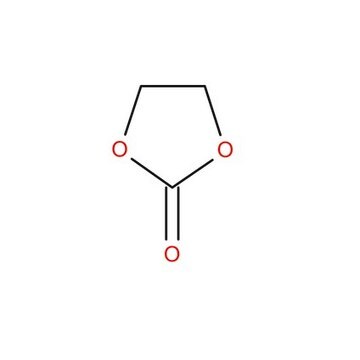517135
Diethyl carbonate
anhydrous, ≥99%
Sinónimos:
Diatol, Eufin, H-DEC
About This Item
Productos recomendados
grado
anhydrous
densidad de vapor
4.1 (vs air)
presión de vapor
10 mmHg ( 23.8 °C)
59 mmHg ( 37.8 °C)
Análisis
≥99%
características de los productos alternativos más sostenibles
Less Hazardous Chemical Syntheses
Safer Solvents and Auxiliaries
Design for Degradation
Learn more about the Principles of Green Chemistry.
sustainability
Greener Alternative Product
impurezas
<0.002% water
<0.005% water (100 mL)
índice de refracción
n20/D 1.384 (lit.)
bp
126-128 °C (lit.)
mp
−43 °C (lit.)
solubilidad
water: insoluble
densidad
0.975 g/mL at 25 °C (lit.)
categoría alternativa más sostenible
cadena SMILES
O=C(OCC)OCC
InChI
1S/C5H10O3/c1-3-7-5(6)8-4-2/h3-4H2,1-2H3
Clave InChI
OIFBSDVPJOWBCH-UHFFFAOYSA-N
¿Está buscando productos similares? Visita Guía de comparación de productos
Categorías relacionadas
Descripción general
Aplicación
- Synthesis of β-enamino esters.
- Synthesis of carbamates and unsymmetrical alkyl carbonates, via reaction with aliphatic amines or alcohols by using a hybrid organic-inorganic material prepared by anchoring TBD to MCM-41 silica.
- As solvent in ruthenium catalyzed direct functionalisation of arene C-H bonds by aryl halides.
- To compose the commercial liquid electrolyte for lithium ion batteries.
- Homogeneous alkoxycarbonylation of cellulose.
Características y beneficios
Palabra de señalización
Warning
Frases de peligro
Consejos de prudencia
Clasificaciones de peligro
Flam. Liq. 3
Código de clase de almacenamiento
3 - Flammable liquids
Clase de riesgo para el agua (WGK)
WGK 1
Punto de inflamabilidad (°F)
77.0 °F - closed cup
Punto de inflamabilidad (°C)
25 °C - closed cup
Equipo de protección personal
Eyeshields, Faceshields, Gloves, type ABEK (EN14387) respirator filter
Certificados de análisis (COA)
Busque Certificados de análisis (COA) introduciendo el número de lote del producto. Los números de lote se encuentran en la etiqueta del producto después de las palabras «Lot» o «Batch»
¿Ya tiene este producto?
Encuentre la documentación para los productos que ha comprado recientemente en la Biblioteca de documentos.
Los clientes también vieron
Artículos
Experts discuss challenges and production processes of nickel-rich layered oxide cathode materials in energy storage systems.
Solid-state lithium fast-ion conductors are crucial for safer, high-energy-density all-solid-state batteries, addressing conventional battery limitations.
Solid oxide fuel cells and electrolyzers show potential for chemical-to-electrical energy conversion, despite early development stages.
Lithium-ion batteries offer high energy density and cyclic performance for portable electronic devices.
Contenido relacionado
Green chemicals evaluation aligns with the 12 Principles of Green Chemistry, emphasizing resource efficiency and hazard reduction.
Nuestro equipo de científicos tiene experiencia en todas las áreas de investigación: Ciencias de la vida, Ciencia de los materiales, Síntesis química, Cromatografía, Analítica y muchas otras.
Póngase en contacto con el Servicio técnico










